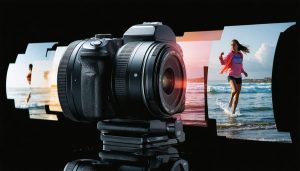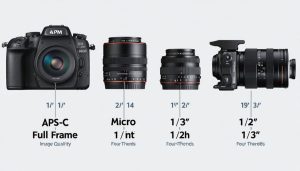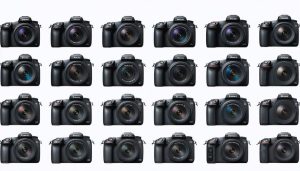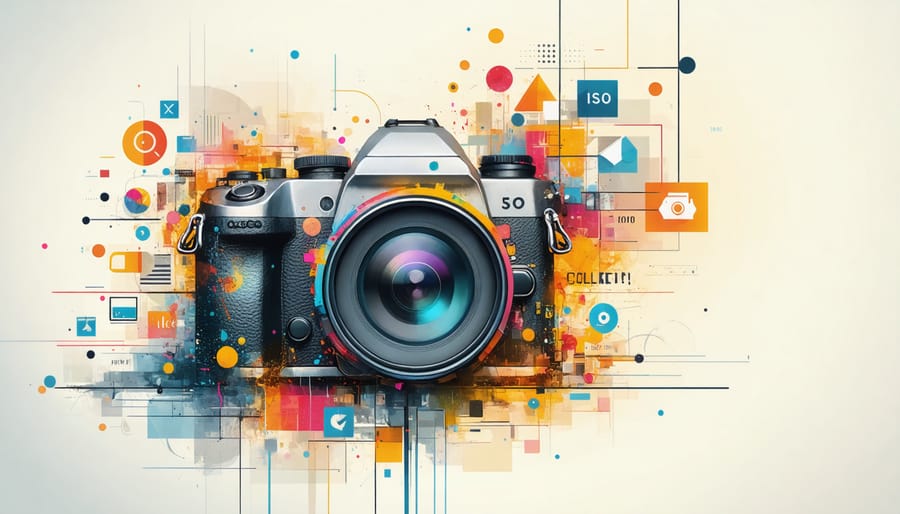
Test your photography expertise with an engaging challenge that transforms technical jargon into memorable knowledge. Like a no-prep vocabulary game for ESL, this interactive journey helps both beginners and seasoned photographers sharpen their technical vocabulary. Beyond mastering photography fundamentals, understanding the language of photography unlocks new creative possibilities and enhances communication with fellow photographers.
From aperture to zebra patterns, this vocabulary challenge covers essential terms across multiple photography disciplines – from basic camera settings to advanced lighting techniques and post-processing terminology. Whether you’re preparing for a photography certification, improving your professional communication, or simply expanding your knowledge base, this challenge provides a structured approach to learning photography’s rich technical vocabulary.
Think of it as your personal photography dictionary coming to life through practical exercises, real-world examples, and interactive quizzes that transform complex concepts into accessible knowledge. Each term comes with context, practical applications, and memory-boosting techniques designed to make learning both effective and enjoyable.
How the Photography Vocabulary Game Works
Game Rules and Setup
To start the Photography Vocabulary Challenge, gather a group of 2-8 players and select a designated game master who will act as the judge. Print out or display the provided vocabulary cards, each containing photography terms and their definitions. The game master shuffles the deck and deals five cards to each player.
During each round, one player becomes the “photographer” and draws an additional card. They must describe the photography term on their card without using the actual word or its variations. Other players listen to the description and try to guess the term within a 60-second time limit.
Players earn two points for correctly guessing the term and the photographer earns one point for a successful description. If no one guesses correctly, no points are awarded. Optional challenge modes include using only technical explanations or describing the term through a real-world photography scenario.
The game continues clockwise, with each player taking turns as the photographer. The first player to reach 15 points wins the game. For solo practice, set a timer and challenge yourself to describe as many terms as possible within five minutes, recording your progress over time.

Scoring and Progression
Players earn points by correctly identifying photography terms, concepts, and equipment through various challenge formats. Each correct answer awards base points, with bonus points available for speed and consecutive correct answers. Quick responses can earn up to 1.5x the base points, encouraging both accuracy and swift thinking.
The game features five progressive difficulty levels: Beginner, Intermediate, Advanced, Expert, and Master. Players start at the Beginner level, focusing on fundamental terms like aperture, shutter speed, and basic composition concepts. To advance to the next level, players must maintain an 80% accuracy rate and accumulate the required point threshold.
Each new level introduces more complex terminology and concepts. The Intermediate level covers lighting techniques and advanced camera settings, while Advanced delves into specialized photography niches and technical specifications. Expert and Master levels challenge players with obscure terms, historical photography knowledge, and cutting-edge technology concepts.
Achievement badges and special titles are awarded at milestone points, creating additional motivation for progression. Weekly leaderboards showcase top performers, adding a competitive element to the learning experience.
Categories of Photography Terms
Camera Body Terms
Let’s explore the essential components that make up your camera’s body. The viewfinder serves as your window to composition, whether optical or electronic, helping you frame your perfect shot. The mode dial is your command center, letting you switch between automatic, manual, aperture priority, and shutter priority modes. Your camera’s grip provides stability and comfort during long shooting sessions, while the hot shoe mount on top allows you to attach external flashes and accessories.
The LCD screen on the back displays your images, camera settings, and live view, while the control wheel or dial enables quick adjustments to exposure settings. Don’t forget about the memory card slot, which stores all your precious captures, and the battery compartment that keeps your camera powered up. The lens mount is crucial, connecting your chosen lens to the camera body, while the shutter button initiates the exposure process.
Understanding these components is essential for mastering your camera’s operation and achieving the results you envision in your photography journey.
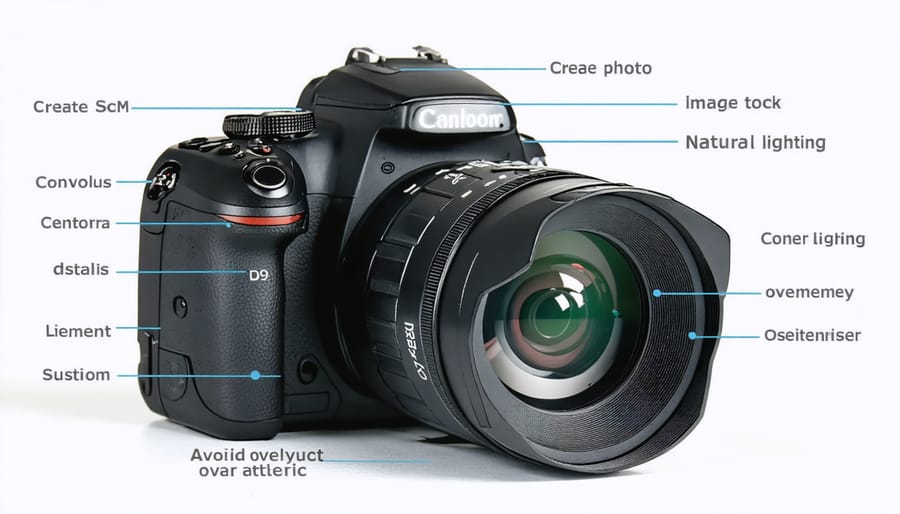
Lens and Optics Vocabulary
Let’s dive into the world of lens and optical terminology, where every millimeter matters! A lens’s focal length, measured in millimeters, determines your field of view – think of it as your eye’s perspective of the scene. Prime lenses offer a fixed focal length, while zoom lenses give you the flexibility to adjust your range.
Aperture, denoted by f-numbers like f/1.8 or f/16, controls how much light enters your camera and affects depth of field. Speaking of which, depth of field refers to the zone of acceptable sharpness in your image – that beautiful blur photographers call bokeh happens when you shoot with a shallow depth of field.
Other essential terms include chromatic aberration (those pesky color fringing effects), distortion (when straight lines appear curved), and vignetting (darkened corners in your image). You’ll also encounter lens elements (individual glass pieces inside), lens groups (sets of elements), and coating (special treatments that reduce flare and ghosting).
Macro photographers often discuss magnification ratios, while landscape shooters frequently mention hyperfocal distance – the focus point that gives maximum depth of field.
Exposure and Light Terms
The exposure triangle and lighting terms form the foundation of understanding exposure and lighting in photography. Let’s explore these essential concepts that every photographer needs to master. Aperture (f-stop) controls the amount of light entering your camera and affects depth of field, while shutter speed determines how long your sensor is exposed to light, creating effects like motion blur or freezing action. ISO measures your camera’s sensitivity to light, though higher values can introduce digital noise.
When it comes to lighting, you’ll encounter terms like ambient light (natural available light), hard light (creating strong shadows), and soft light (producing gentle transitions). Key light refers to the main light source, while fill light helps reduce shadows. Rim lighting creates that beautiful edge glow around subjects, and backlighting can produce dramatic silhouettes or ethereal effects.
Understanding terms like dynamic range (the scope between the brightest and darkest parts of an image) and exposure compensation (intentionally adjusting exposure up or down) will help you master the technical aspects of photography while developing your creative vision.
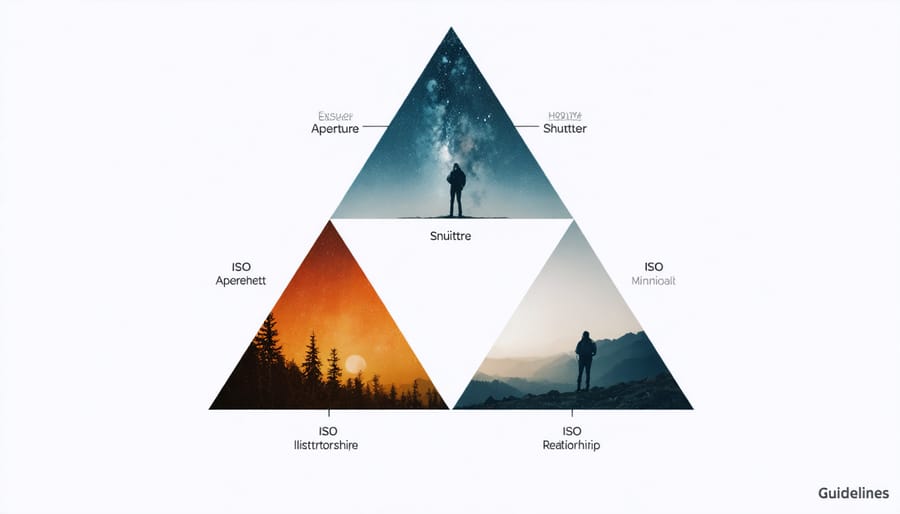
Post-Processing Terms
In the world of modern photography, mastering digital editing techniques is just as important as capturing the perfect shot. Let’s explore some essential post-processing terms that every photographer should know. ‘Dodge and burn’ refers to selectively lightening or darkening specific areas of an image, while ‘curves’ allows precise control over tonal range and contrast. ‘White balance’ helps adjust color temperature, ensuring your images don’t appear too warm or cool.
‘Layers’ are like transparent sheets stacked on top of your image, enabling non-destructive editing, while ‘masks’ let you hide or reveal specific adjustments. ‘Clone stamp’ and ‘healing brush’ tools help remove unwanted elements from your photos. Understanding terms like ‘saturation’ (color intensity), ‘vibrance’ (selective color enhancement), and ‘clarity’ (mid-tone contrast) will help you create images that pop.
Don’t forget about ‘sharpening’ to enhance detail, and ‘noise reduction’ to smooth out grainy areas in your photos. These terms form the foundation of modern photo editing workflow.
Tips for Mastering Photography Terms
Memory Techniques
Mastering photography terminology becomes much easier when you employ effective memory techniques. One powerful method is the visualization approach – associate each technical term with a vivid mental image. For instance, imagine “bokeh” as tiny fairy lights dancing in the background of your photo, or “vignetting” as a dark frame slowly creeping in from the edges of your viewfinder.
Create memorable acronyms for groups of related terms. Remember the exposure triangle with “ASI” – Aperture, Shutter speed, and ISO. For lens-related terms, try “FMZ” – Focal length, Mount type, and Zoom range.
Another effective technique is the chunking method – group similar terms together. For example, cluster lighting terms (strobe, softbox, diffuser) or composition elements (leading lines, rule of thirds, symmetry). This organization helps your brain create logical connections and retrieve information more efficiently.
Practice active recall by creating flashcards or using spaced repetition apps. Review terms regularly, but space out your practice sessions to strengthen long-term retention. Try explaining concepts to others – teaching reinforces learning and helps identify gaps in your understanding.
Finally, connect terms to real-world scenarios. When you encounter a new term, immediately think of how you’d use it in your next photo shoot. This practical association makes technical vocabulary more relevant and memorable.
Practice Exercises
Ready to put your photography vocabulary to the test? Here are some engaging exercises to help reinforce your learning:
1. Photo Walk Challenge: Take a 30-minute walk with your camera and identify at least 10 different photography terms in action. Document examples of bokeh, leading lines, or golden hour lighting as you encounter them.
2. Technical Term Matching: Create flashcards pairing technical terms with their everyday explanations. Match “aperture” with “the opening that lets light in” or “ISO” with “light sensitivity.” Practice daily to enhance your technical skills.
3. Composition Bingo: Make a bingo card with different composition terms. Go through your photo library or take new photos to find examples of each technique, marking them off as you go.
4. Gear Description Game: Practice describing your camera equipment using proper terminology. Challenge yourself to explain your setup to a fellow photographer without using basic terms like “camera” or “lens.”
5. Term-of-the-Day Shoot: Select one photography term each day and create three images that demonstrate that concept. Share your results with other photographers and discuss your interpretation of the term.
These exercises work best when practiced regularly and shared with other photography enthusiasts. Consider joining a local photography group to make the learning experience more interactive and enjoyable.
Taking on the photography vocabulary challenge is more than just a fun way to test your knowledge – it’s an investment in your growth as a photographer. By regularly engaging with photography terminology through this interactive format, you’ll naturally incorporate these terms into your daily practice, leading to more precise communication with fellow photographers and clients alike.
The beauty of this challenge lies in its versatility. Whether you’re a beginner trying to master the basics or a seasoned professional looking to stay sharp, there’s always something new to learn and reinforce. As you progress through different difficulty levels, you’ll find yourself becoming more confident in discussing technical aspects of photography, making equipment choices, and explaining concepts to others.
Remember, every expert photographer started as a beginner, learning one term at a time. This challenge provides a structured, engaging way to build your photography vocabulary without the pressure of formal study. The game-like format makes learning enjoyable, while the competitive element can motivate you to push yourself further.
Why not start today? Challenge yourself to learn five new terms this week, or compete with photography friends to see who can master the most vocabulary in a month. Set personal goals, track your progress, and celebrate your achievements as you expand your photography lexicon.
The more comfortable you become with photography terminology, the more confidently you’ll approach new techniques and equipment. This knowledge will enhance your creative process, allowing you to focus more on capturing amazing images and less on decoding technical instructions or articles.
So, take the first step. Start with the beginner level, work your way through the challenges, and watch as your understanding of photography deepens with each new term you master. Your future self will thank you for investing this time in building such a crucial foundation for your photography journey.



